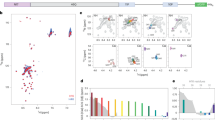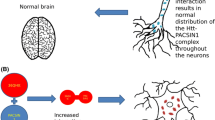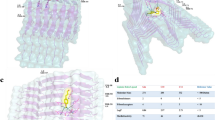Abstract
Huntington’s disease patients commonly have glutamine (Q) repeats longer than 37 residues in the Huntingtin protein. This unusual protein will misfold and aggregate to form insoluble amyloid-like fibrils. Although the determination of polyQ structure is very important for elucidation of the aggregation mechanism, this has not yet been accomplished due to the experimental difficulties. In this study, we performed in silico mutation analysis to examine the stability of polyQ peptide on the basis of the β-helix structure which is known as a possible model. From the results of molecular dynamics simulations for 10ns, some mutant models were found to be unstable, and their stabilities were largely dependent on the position of replaced residues. Besides, to examine the relationship between the aggregation mechanism of polyQ and the stability of the corresponding monomer, we constructed trimer models. Through the trimer studies, we confirmed that the stability of the monomer contributes significantly to that of the oligomer, and found that some mutant polyQs have the ability to inhibit polyQ aggregation. Furthermore, we estimated the free energies in solution and the conformational entropic contributions with normal mode analysis. The entropic contributions were not exhibiting remarkable differences between the models under study compared to the differences in the free energies in solution. Supposing that the stability of monomer is associated with aggregation process, the β-helix structure has been found to be somewhat inconsistent with the experimental results in this study. Our results thus indicate the necessity for the revalidation of the β-helix model.
Similar content being viewed by others
Abbreviations
- polyQ:
-
polyglutamine
- MD:
-
molecular dynamics
- MOE:
-
Molecular Operating Environment
- PBC:
-
periodic boundary condition
- RMSD:
-
root mean square deviation
- RMSF:
-
root mean square fluctuation
- WT:
-
wildtype
- PG pair:
-
Pro-Gly pair
References
Bevivino, A.E., Loll, P.J 2001. An expanded glutamine repeat destabilizes native ataxin-3 structure and mediates formation parallel beta-fibrils. In: Proceedings of the National Academy of Sciences of the United States of America 98, 11955–11960.
Chen, S., Berthelier, V., Hamilton, J.B., O’Nuallain, B., Wetzel, R 2002. Amyloid-like features of polyglutamine aggregates and their assembly kinetics. Biochemistry 41, 7391–7399.
Connolly, M.L. 1983. Analytical molecular surface calculation. Journal of Applied Crystallography 16, 548–558.
Cooper, J.K., Schilling, G., Peters, M.F., Herring, W.J., Sharp, A.H., Kaminsky, Z., Masone, J., Khan, F.A., Delanoy, M., Borchelt, D.R., Dawson, V.L., Dawson, T.M., Ross, C.A. 1998. Truncated N-terminal fragments of huntingtin with expanded glutamine repeats form nuclear and cytoplasmic aggregates in cell culture. Human Molecular Genetics 7, 783–790.
de Cristofaro, T., Affaitati, A., Cariello, L., Avvedimento, E.V., Varrone, S. 1999. The length of polyglutamine tract, its level of expression, the rate of degradation, and the transglutaminase activity influence the formation of intracellular aggregates. Biochemical and Biophysical Research Communications 260, 150–158.
Elliott, J., Starikov, E.B., Crawshaw, J., Claiden, P., Nilsson, L., Windle, A 2006. Nucleation of polyglutamine amyloid fibres modelling using molecular dynamics. In: Starikov, E., Lewis, J., Tanaka, S. (eds) Modern Methods for Theoretical Physical Chemistry of Biopolymers. Elsevier BV, Amsterdam, The Netherlands, 211–216.
Georgalis, Y., Starikov, E.B., Hollenbach, B., Lurz, R., Scherzinger, E., Saenger, W., Lehrach, H., Wanker, E.E. 1998. Huntingtin aggregation monitored by dynamic light scattering. In: Proceedings of the National Academy of Sciences of the United States of America 95, 6118–6121.
Jorgensen, W.L., Chandrasekhar, J., Madura, J.D., Impey, R.W., Klein, M.L. 1983. Comparison of simple potential functions for simulation liquid water. The Journal of Chemical Physics 79, 926–935.
Kollman, P.A., Massova, I., Reyes, C., Kuhn, B., Huo, S., Chong, L., Lee, M., Lee, T., Duan, Y., Wang, W., Donini, O., Cieplak, P., Srinivasan, J., Case, D.A., Cheatham, T.E. III 2000. Calculating structures and free energies of complex molecules: combining molecular mechanics and continuum models. Accounts of Chemical Research 33, 889–897.
MacDonald, M.E. et al. (The Huntington’s Disease Collaborative Research Group). 1993. A novel gene containing a trinucleotide repeat that is expanded and unstable on Huntington’s disease chromosomes. Cell 72, 971–983.
Merlino, A., Esposito, L., Vitagliano, L 2006. Polyglutamine repeats and β-helix structure: Molecular dynamics study. Proteins 63, 918–927.
Molecular Operating Environment, 2006. Chemical Computing Group, Montreal, Canada.
Ogawa, H., Nakano, M., Watanabe, H., Starikov, E.B., Rothstein, S.M., Tanaka, S 2008. Molecular dynamics simulation study on the structural stabilities of polyglutamine peptides. Computational Biology and Chemistry 32, 102–110.
Pearlman, D.A., Case, D.A., Caldwell, J.W., Ross, W.S., Cheatham, T.E. III, DeBolt, S., Ferguson, D., Seibel, G., Kollman, P. 1995. AMBER, a package of computer programs for applying molecular mechanics, normal mode analysis, molecular dynamics and free energy calculations to simulate the structural and energetic properties of molecules. Computer Physics Communications 91, 1–41.
Perutz, M.F., Johnson, T., Suzuki, M., Finch, J.T. 1994. Glutamine repeats as polar zippers: their possible role in inherited neurodegenerative diseases. In: Proceedings of the National Academy of Sciences of the United States of America 91, 5355–5358.
Perutz, M.F., Finch, J.T., Berriman, J., Lesk, A 2002. Amyloid fibers are water-filled nanotubes. In: Proceedings of the National Academy of Sciences of the United States of America 99, 5591–5595.
PyMOL viewer v0.99. DeLano Scientific LLC, South San Francisco, USA
Rubinsztein, D.C., Leggo, J., Coles, R., Almqvist, E., Biancalana, V., Cassiman, J.J., Chotai, K., Connarty, M., Crauford, D., Curtis, A., Curtis, D., Davidson, M.J., Differ, A.M., Dode, C., Dodge, A., Frontali, M., Ranen, N.G., Stine, O.C., Sherr, M., Abbott, M.H., Franz, M.L., Graham, C.A., Harper, P.S., Hedreen, J.C., Jackson, A., Kaplan, J.C., Losekoot, M., MacMillan, J.C., Morrison, P., Trottier, Y., Novelletto, A., Simpson, S.A., Theilmann, J., Whittaker, J.L., Folstein, S.E., Ross, C.A., Hayden, M.R. 1996. Phenotypic characterization of individuals with 30-40 CAG repeats in the Huntington disease (HD) gene reveals HD cases with 36 repeats and apparently normal elderly individuals with 36-39 repeats. American Journal of Human Genetics 59, 16–22.
Scherzinger, E., Lurz, R., Turmaine, M., Mangiarini, L., Hollenbach, B., Hasenbank, R., Bates, G.P., Davies, S.W., Lehrach, H., Wanker, E.E. 1997. Huntingtin-encoded polyglutamine expansions form amyloid-like protein aggregates in vitro and in vivo. Cell 90, 549–558.
Sharma, D., Sharma, S., Pasha, S., Brahmachari, S.K. 1999. Peptide models for inherited neurodegenerative disorders: conformation and aggregation properties of long polyglutamine peptides with and without interruptions. FEBS Letters 456, 181–185.
Sharma, D., Shinchuk, L.M., Inouye, H., Wetzel, R., Kirschner, D.A 2005. Polyglutamine homopolymers having 8-45 residues form slablike beta-crystallite assemblies. Proteins 61, 398–411.
Sikorski, P., Atkins, E 2005. New model for crystalline polyglutamine assemblies and their connection with amyloid fibrils. Biomacromolecules 6, 425–432.
Singer, S.J., Dewji, N.N 2006. Evidence that Perutz’s double-beta-stranded subunit structure for betaamyloids also applies to their channel-forming structures in membranes. In: Proceedings of the National Academy of Sciences of the United States of America 103, 1546–1550.
Srinivasan, J., Cheatham, T.E. III, Cieplak, P., Kollman, P.A., Case, D.A. 1998. Continuum solvent studies of the stability of DNA, RNA, and phosphoramidate-DNA helices. Journal of the American Chemical Society 120, 9401–9409.
Stork, M., Giese, A., Kretzschmar, H.A., Tavan, P 2005. Molecular dynamics simulations indicate a possible role of parallel beta-helices in seeded aggregation of poly-Gln. Biophysical Journal 88, 2442–2451.
Suhre, K., Sanejouand, Y.H 2004. ElNémo: a normal mode web server for protein movement analysis and the generation of templates for molecular replacement. Nucleic Acids Reserch 32, W610–614. doi:10.1093/nar/gkh368.
Taiji, M 2004. MDGRAPE-3 chip: a 165 Gflops Application Specific LSI for Molecular Dynamics Simulations. In: Proceedings of Hot Chips 16 in CD-ROM, IEEE Computer Society.
Tanaka, M., Morishima, I., Akagi, T., Hashikawa, T., Nukina, N 2001. Intra- and intermolecular -pleated sheet formation in glutamine-repeat inserted myoglobin as a model for polyglutamine diseases. The Journal of Biological Chemistry 276, 45470–45475.
Thakur, A.K., Wetzel, R 2002. Mutational analysis of the structural organization of polyglutamine aggregates. In: Proceedings of the National Academy of Sciences of the United States of America 99, 17014–17019.
Thakur, A.K., Yang, W., Wetzel, R 2004. Inhibition of polyglutamine aggregate cytotoxicity by a structurebased elongation inhibitor. The FASEB Journal 18, 923–925.
van der Spoel, D., Lindahl, E., Hess, B., Groenhof, G., Mark, A.E., Berendsen, H.J 2005. GROMACS: fast, flexible, and free. Journal of Computational Chemistry 26, 1701–1718.
Wang, J.M., Cieplak, P., Kollman, P.A 2000. How well does a restrained electrostatic potential (RESP) model perform in calculating conformational energies of organic and biological molecules? Journal of Computational Chemistry 21, 1049–1074.
Author information
Authors and Affiliations
Corresponding author
Rights and permissions
About this article
Cite this article
Nakano, M., Watanabe, H., Starikov, E. et al. Mutation effects on structural stability of polyglutamine peptides by molecular dynamics simulation. Interdiscip Sci Comput Life Sci 1, 21–29 (2009). https://doi.org/10.1007/s12539-008-0020-7
Received:
Revised:
Accepted:
Published:
Issue Date:
DOI: https://doi.org/10.1007/s12539-008-0020-7




